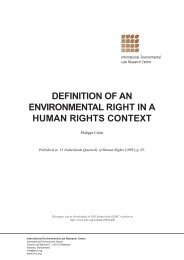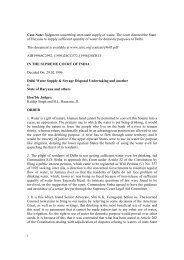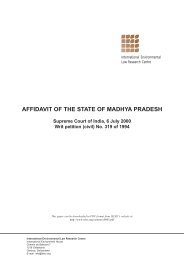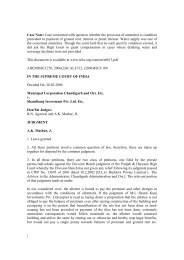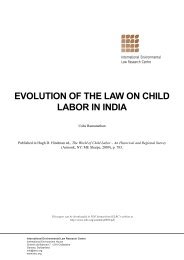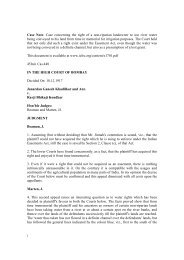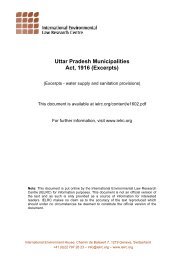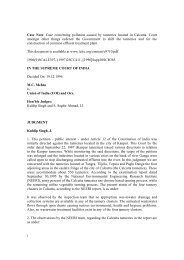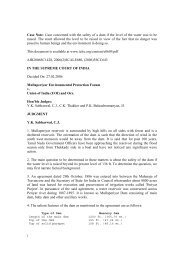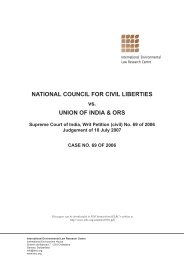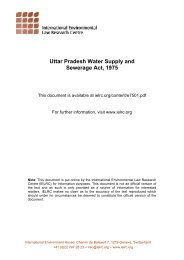Narmada Bachao Andolan vs. Union of India - International ...
Narmada Bachao Andolan vs. Union of India - International ...
Narmada Bachao Andolan vs. Union of India - International ...
Create successful ePaper yourself
Turn your PDF publications into a flip-book with our unique Google optimized e-Paper software.
Limited issued an approach paper on environmental impact assessment for the river reach downstream. Thisprovided technical understanding <strong>of</strong> the likely hydrological changes and possible impact in relation thereto. It wasfurther submitted by learned counsel for the respondents that the potential for environmental changes in the lowerriver and estuary had to be seen in the context <strong>of</strong> the long term development <strong>of</strong> the basin. The current stage wasclearly beneficial. The three stages could be identified as follows:Stage 1 covers the period roughly from the completion <strong>of</strong> Sardar Sarovar Dam to the year 2015. Events occurringduring this stage include (a) SSP Canal Command will have reached full development and required diversion <strong>of</strong>some water, (b) the upstream demand will reach about 8 MAF and (c) the <strong>Narmada</strong> Sagar Dam will have beenbuilt and placed in operation.Stage 2 covers the period from 2015 and 2030 during which the demands upstream <strong>of</strong> SSP continue to grow andwill reach about 12 MAF still below the volume <strong>of</strong> 18 MAF that Madhya Pradesh can take in 75 percent year.Stage 3 covers the period upto and beyond full basin development.The report given by M/s. H.R. Wallingford in March 1993 in respect <strong>of</strong> the downstream impacts <strong>of</strong> Sardar SarovarDam observers, inter alia, as under:The overall conclusion <strong>of</strong> the team undertaking the assessment described in this report is that there areno down stream impacts whose magnitude and effect are such as to cause doubts to be cast over thewisdom <strong>of</strong> proceeding with the Sardar Sarovar Projects provided that appropriate monitoring andmitigation measures are applied. Much <strong>of</strong> this work is already in progress under the auspices <strong>of</strong> theNPG, SSNNL and NCA. The recommendations in this report are intended to provide a synthesis <strong>of</strong> theirwork and suggestions as to whether it might be modified to enhance its usefulness.The said M/s. H.R. Wallingford in the findings <strong>of</strong> 1995 stated as under:It is thought unlikely that any significant negative environmental impacts will occur over the next 30years as a result <strong>of</strong> the project. Some possible adverse effects have been identified, the main one beingthe effect <strong>of</strong> flood attenuation on Hilsa migration. These need to be monitored and more studies undertakento better understand the conditions which trigger spawning. Beneficial impacts in this period includereduced flooding and more reliable dry season flows as well as an overall improvement <strong>of</strong> the health andwell being <strong>of</strong> the people to the reliable domestic water supply, improved nutrition and enhanced economicactivity.The above report clearly demonstrates that the construction <strong>of</strong> dam would result into more regulated and perennialflow into the river with an overall beneficial impact. It is also evident that until all the dams are constructedupstream and the entire flow <strong>of</strong> river is harnessed, which is not likely in the foreseeable future, there is no question<strong>of</strong> adverse impact including the fishing activity and the petitioner’s assertions in this regard are ill-conceived.138. The area <strong>of</strong> submergence was stated to be rich in archaeological remains but it still remained to be studied. Itwas contended that there was danger <strong>of</strong> rich historical legacy being lost and even a small increase in the damheight would threaten to submerge many <strong>of</strong> the sites listed in the report <strong>of</strong> the Archaeological Survey <strong>of</strong> <strong>India</strong>.There were stated to be five monuments which would be affected at dam height <strong>of</strong> 90 meter or above and no workwas stated to have commenced to protect any <strong>of</strong> the five monuments.139. According to the State <strong>of</strong> Gujarat, the Ancient Monuments and Archaeological Sites and Remains Act, 1958charged the Central and/or State Department <strong>of</strong> Archaeology with responsibility for the protection <strong>of</strong> importantcultural sites. Under the Act, sites were classified into three categories as follows:Type 1: Monuments <strong>of</strong> national importance which are protected by the Central Government;Type 2: Monuments <strong>of</strong> religious or cultural importance which are protected by the State Government; andType 3: Monuments which are neither centrally nor state protected, but which are considered to be an importantpart <strong>of</strong> cultural heritage.Under the same law, authorities charged with the protection <strong>of</strong> the monuments are permitted to take suitablemeasures to ensure the preservation <strong>of</strong> any protected site under threat from decay, misuse or economic activity.29



